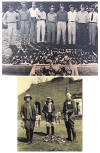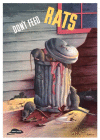History, Rats, Fleas, and Opossums: The Ascendency of Flea-Borne Typhus in the United States, 1910-1944
- PMID: 32121541
- PMCID: PMC7157735
- DOI: 10.3390/tropicalmed5010037
History, Rats, Fleas, and Opossums: The Ascendency of Flea-Borne Typhus in the United States, 1910-1944
Abstract
Flea-borne typhus, due to Rickettsia typhi and Rickettsia felis, is an infection causing fever, headache, rash, hepatitis, thrombocytopenia, and diverse organ manifestations. Although most cases are self-limited, 26%-28% have complications and up to one-third require intensive care. Flea-borne typhus was recognized as an illness similar to epidemic typhus, but having a milder course, in the Southeastern United States and TX from 1913 into the 1920s. Kenneth Maxcy of the US Public Health Service (USPHS) first described the illness in detail and proposed a rodent reservoir and an arthropod vector. Other investigators of the USPHS (Eugene Dyer, Adolph Rumreich, Lucius Badger, Elmer Ceder, William Workman, and George Brigham) determined that the brown and black rats were reservoirs and various species of fleas, especially the Oriental rat flea, were the vectors. The disease was recognized as a health concern in the Southern United States in the 1920s and an increasing number of cases were observed in the 1930s and 1940s, with about 42,000 cases reported between 1931-1946. Attempts to control the disease in the 1930s by fumigation and rat proofing and extermination were unsuccessful. The dramatic increase in the number of cases from 1930 through 1944 was due to: the diversification of Southern agriculture away from cotton; the displacement of the smaller black rat by the larger brown rat in many areas; poor housing conditions during the Great Depression and World War II; and shortages of effective rodenticides and insecticides during World War II.
Keywords: Rickettsa typhi; Rickettsia felis; fleas; insecticide; murine typhus; rats; rodenticide.
Conflict of interest statement
The author declares that there are no conflicts of interest regarding the publication of this paper.
Figures












References
-
- Smadel J.E. Status of the rickettsioses in the United States. Ann. Intern. Med. 1959;51:421–435. - PubMed
Publication types
LinkOut - more resources
Full Text Sources

